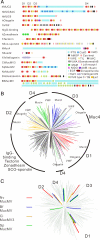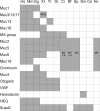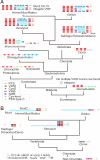Gel-forming mucins appeared early in metazoan evolution
- PMID: 17911254
- PMCID: PMC2042186
- DOI: 10.1073/pnas.0705984104
Gel-forming mucins appeared early in metazoan evolution
Abstract
Mucins are proteins that cover and protect epithelial cells and are characterized by domains rich in proline, threonine, and serine that are heavily glycosylated (PTS or mucin domains). Because of their sequence polymorphism, these domains cannot be used for evolutionary analysis. Instead, we have made use of the von Willebrand D (VWD) and SEA domains, typical for mucins. A number of animal genomes were examined for these domains to identify mucin homologues, and domains of the resulting proteins were used in phylogenetic studies. The frog Xenopus tropicalis stands out because the number of gel-forming mucins has markedly increased to at least 25 as compared with 5 for higher animals. Furthermore, the frog Muc2 homologues contain unique PTS domains where cysteines are abundant. This animal also has a unique family of secreted mucin-like proteins with alternating PTS and SEA domains, a type of protein also identified in the fishes. The evolution of the Muc4 mucin seems to have occurred by recruitment of a PTS domain to AMOP, NIDO, and VWD domains from a sushi domain-containing family of proteins present in lower animals, and Xenopus is the most deeply branching animal where a protein similar to the mammalian Muc4 was identified. All transmembrane mucins seem to have appeared in the vertebrate lineage, and the MUC1 mucin is restricted to mammals. In contrast, proteins with properties of the gel-forming mucins were identified also in the starlet sea anemone Nematostella vectensis, demonstrating an early origin of this group of mucins.
Conflict of interest statement
The authors declare no conflict of interest.
Figures




References
-
- Perez-Vilar J, Hill RL. J Biol Chem. 1999;274:31751–31754. - PubMed
-
- Hollingsworth MA, Swanson BJ. Nat Rev Cancer. 2004;4:45–60. - PubMed
-
- Macao B, Johansson DG, Hansson GC, Hard T. Nat Struct Mol Biol. 2006;13:71–76. - PubMed
-
- Godl K, Johansson ME, Lidell ME, Morgelin M, Karlsson H, Olson FJ, Gum JR, Jr, Kim YS, Hansson GC. J Biol Chem. 2002;277:47248–47256. - PubMed
-
- Van der Sluis M, De Koning BA, De Bruijn AC, Velcich A, Meijerink JP, Van Goudoever JB, Buller HA, Dekker J, Van Seuningen I, Renes IB, et al. Gastroenterology. 2006;131:117–129. - PubMed
Publication types
MeSH terms
Substances
LinkOut - more resources
Full Text Sources
Other Literature Sources
Molecular Biology Databases
Research Materials
Miscellaneous

